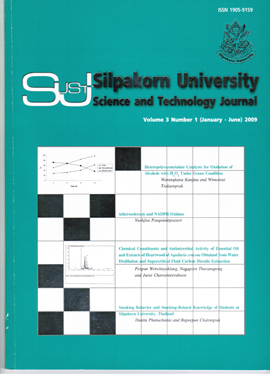Smoking Behavior and Smoking-Related Knowledge of Students at Silpakorn University, Thailand
Main Article Content
Abstract
The aim of this study was to obtain information about smoking behavior and smoking-related knowledge ofstudents at Silpakorn University, Sanamchan Palace Campus, located in Nakhon Pathom Province, Thailand. Across sectional study was designed to collect data by self-administered, personal questionnaires in 137 studentswho smoked; information from 9 faculties was obtained from July 8th to August 4th, 2006. The questionnaireincluded items about daily consumption of cigarettes, income per month, age at which smoking began, previousattempts to quit smoking, smoking cessation techniques, campaigns against smoking, smoking-relatedknowledge and the reasons for smoking among the students sampled.The study result was that of the 137 enrolled university students who smoked, 89.8% were men. Averagedaily consumption were 8.6±7.3 cigarettes and average income per month was 5,537.40 Baht. Mean age ofinitiation of smoking was 17.1±2.3 years. Nearly one third, 29.2% of smoking students had never tried to quitsmoking while 13.9% stated they had tried to quit more than 3 times. The smoking cessation techniques includedthe cigarette buying method, no-smoke self-enforcement method and the exercise and water drinking/frequentbathing method. Some subjects used nicotine chewing gum or cessation medicine and limited party going orstayed away from other smokers. Few of them took counselings at smoking cessation clinics. Most students hadseen campaigns against smoking on television, billboards, newspapers or magazines. Most students thought thatcigarettes were addictive and could hurt one or cause bad health effects for smokers as well as passive smokers.Some students had never tried to quit smoking for various reasons such as smoking was not addictive, it wasunnecessary to quit smoking, and smoking was a source of pleasure. The main given reasons for smoking in thesamples were stress relief, gaining happiness, free time operation, habitation, and peer pressure. The reasons forsmoking again after having stopped for a period were stress, relieving sadness or emotional problems, peerpressure, habitation, no strong intention or quit attempt, taste addiction and weight gain after cessation. Students who have never tried to quit smoking should be aware of their chances to get disease/prematuredeath from cigarettes. They also should be educated about the toxic chemicals in cigarettes which not only harmsmokers but also passive smokers such as their parents, friends and families. Some misconceptions of studentswho never tried to quit smoking should be changed to stimulate them to begin the cessation process. Studentswho again smoked after having some cessation period should be provided some information on techniques tohelp them succeed in the future.
Downloads
Article Details
References
Bank of Thailand. (2007). Table 80 : Gross National Product by Industry and National Income at Current Market Prices. [Online URL:www.bot.or.th/Bothomepage/Databank/EconData/EconFinance/tab80e.asp] accessed on May 4, 2007.
Doll, R., Peto, R., Boreham, J. and Sutherland, I. (2004). Mortality in Relation to Smoking: 50 Years’ Observations on Male British Doctors. British Medical Journal, 328: 1519-1527.
Israel, G. (2007). Determining Sample Size. [Online URL: edis.ifas.ufl.eduPD006#FOOTNOTE_1] accessed on April 2nd, 2007.
Jha, P. (2008) Death and Tobacco Taxes. [OnlineURL:www.project-syndicate.org/commentary/jha1] accessed on January 14, 2008.
Mas, A., Nerín, I., Barrueco, M., Cordero, J., Guillén, D., Jiménez-Ruiz, C., and Sobradillo, V. (2004). Smoking Habits among Sixth-year Medical Students in Spain, 40(9):403-8. [Online URL:www.archbronconeumol.org] accessed on March 5, 2007.
National Statistic Office of Thailand (2007). [OnlineURL: service.nso.go.th/nso/data/data23/stat_23/toc_4/(file name 4.4-4-47.xls)] accessed on January 11, 2007.
Vathesatogkit, P.(2008). Smoking Teenage. [Online URL: www.ashthailand. or.th/th/content_image/informationcenter/126.pdf] accessed on January 14, 2008.
Public Relations Department of Thailand.(2007)Tighter tobacco control regulations [OnlineURL: thailand.prd.go.th/the_inside. php?id=644] accessed on May 8, 2007.
Siahpush, M., McNeill, A., Hammond, D. and Fong, GT. (2006). Socioeconomic and Country Variations in Knowledge of Health Risks of Tobacco Smoking and Toxic Constituents of Smoke: Results from the 2002 International Tobacco Control (ITC) Four Country Survey. Tobacco Control, 15: 65-70.
Supawongse, C. (2005). Two Decades of Tobacco-consumption Control in Thailand: Success and Challenges, presented at the Sixth Global. Conference on Health Promotion organized by the World Health Organization and the Ministry of Public Health of Thailand at the United Nations Conference Centre, Bangkok, Thailand. 7-11 August 2005. [Online URL:www.anamai.moph.go.th/6thglobal/05_2decades.pdf] accessed on April 2, 2007.
The ASPECT Consortium. (2004). Tobacco or Health in the European Union: Past Present and Future, 255: 28-31. [Online URL: europa.eu.int] accessed on March 4, 2007.
Tobacco-Related Disease Research Program.(2007). Nitrogen Oxides and Cigarette Smoke-inducedInjury. [Online URL: www.trdrp.org/fundedresearch/Views/Grant_Page.asp?grant_id=532] accessed on August 14, 2007.


